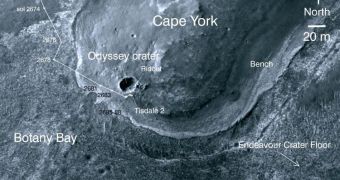Officials at the American space agency say that the Mars Reconnaissance Orbiter (MRO) spacecraft was recently able to snap a new image of the Mars Exploration Rover (MER) Opportunity, which currently lies on the rim of the massive Endeavour Crater.
The explorations robot has been driving towards this landscape feature for the past three years, and not many expected for it to actually make it. Now that Opportunity is parked at the crater, experts are doing their best to collect as much science data as possible.
The latest efforts by the MRO team are in tune with this effort. The investigators usually train the sensitive instruments aboard the orbiter to interesting landscape features such as dried-up riverbeds and deltas, but they took time out of their efforts recently to image the MER robot.
In order to do this, they used the High Resolution Imaging Science Experiment (HiRISE) camera aboard the MRO. This is one of the most sensitive telescopes ever deployed on a space exploration mission throughout the solar system.
It has a tremendous level of resolution, and is capable of detecting very small objects on the surface of Mars. Even if Opportunity is not exactly small, it still appears as only a smudge on the MRO datasets. The image was collected on September 10, or sol 2712.
It shows Opportunity still investigating Tisdale 2, a rock that experts at the NASA Jet Propulsion Laboratory, in Pasadena, California, determined to be very interesting. The JPL manages the MER program for the NASA Science Mission Directorate, at the agency's Headquarters, in Washington DC.
The rover landed on Mars in January 2004, and has spent the intervening time scanning the surface of the Red Planet, and conducting geological analysis of the surrounding landscapes. Throughout its lifespan, Opportunity traveled more than 33 kilometers (20 miles).
This is the equivalent of more than 50 times the distance its developers originally intended for it to travel. Sturdy engineering and built-in redundancies allowed JPL mission controllers to keep the rover in place for a very long time. They were not as successful with Spirit though.
Now that Opportunity is at Endeavour Crater, it will most likely spend the rest of its lifespan on Mars investigating the geological layers the landscape feature exposes, Universe Today reports. Experts hope to gain new insights into the Red Planet's former water cycle from such studies.

 14 DAY TRIAL //
14 DAY TRIAL //